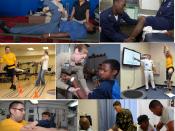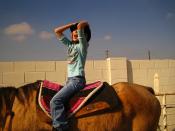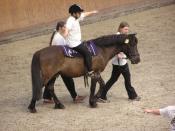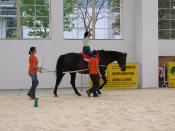� AUTHOR �Debbie Holmes� - � PAGE �3�-
Debbie Holmes
Dr. G Pardi
Bio160
21 November 2008
Hippotherapy
The medical use of the horse, which addresses people with neuromotor dysfunction, is called Hippotherapy. This type of therapy is currently being used for a variety of medical conditions such as autism, cerebral palsy, down syndrome, and sensory processing disorders. However, hippotherapy is not for every patient and requires specially trained professionals to facilitate the safe and effective use of the horse. There are specific contraindications and precautions for some conditions and diagnosis that must be adhered to in order to insure the safety of the rider.
Although many people associate this type of treatment with physical therapy, hippotherapy as a speech and language therapy strategy is becoming more common. Hippotherapy uses a horse to achieve conventional speech, language, cognitive, and swallowing goals. Carefully modulated, well cadenced equine movement offers a helpful means of addressing these deficits through the facilitation of the physiological systems that support speech and language function.
Utilizing hippotherapy, appropriate sensory processing strategies integrated into the treatment plan assist in achieving successful communication goals.
Hippotherapy Defined
Hippotherapy literally means "treatment with the help of a horse" from the Greek word, "hippos" meaning horse. The American Hippotherapy Association, (AHA), has defined
Hippotherapy as a "term that refers to the use of the movement of the horse as a strategy by Physical Therapists, Occupational Therapists, and Speech-Language Pathologists to address impairments, functional limitations, and disabilities in patients with neuromusculoskeletal dysfunction. This strategy is used as part of an integrated treatment program to achieve functional outcome" (AHA 2000). In Hippotherapy, the horse influences the client rather than the client controlling the horse. The therapist or instructor directs the movement of the horse and analyzes the client's response.
History
The therapeutic value of horseback riding goes back centuries although the origin of organized therapeutic riding is a relatively new treatment option. In 1952, Liz Hartel of Denmark won the silver medal for Grand Prix dressage at the Helsinki Olympics. This is a grand achievement for any rider but for Liz it was extremely special because she suffered from Polio. Medical and equine professionals took notice and soon centers for therapeutic riding sprang up in Europe.
Canadians and Americans studied what was happening in England and quickly made plans to start centers. Two of the first were the Community Association of Riding for the Disabled (CARD) in Toronto, Ontario, and the Cheff Center for the Handicapped in Augusta, Michigan. As interest spread to the states, a group of individuals got together in 1969 and formed the North American Riding for the Handicapped Association, (NARHA). This organization offers instructor training and certification as well as on going continuing education. There are approximately eight hundred NARHA centers worldwide serving over 38,000 clients each year.
Why A Horse?
Good question! The horse's pelvis has the same three-dimensional movement of the human's pelvis at the walk. This three dimensional movement provides physical and sensory input, which is variable, rhythmic and repetitive. The variability of the horse's gait enables the therapist to grade the degree of input to the patient. These movements are utilized in combination with other treatment strategies to achieve desired therapy goals or functional outcomes. In addition, the three-dimensional movement of the horse's pelvis leads to a movement response in the patient's pelvis that is similar to the movement patterns of human walking. The warmth of the horse coupled with this
A clinical trial conducted by Dolores Bertoti in 1988 showed that significant improvement in posture was achieved during a period of therapeutic riding. Eleven children with moderate to severe spastic cerebral palsy, aged 2 to 9 years, participated in this study. They underwent postural assessments according to a repeated-measures design, (two pretests at 10-week intervals and a posttest). A panel of three pediatric physical therapists performed postural assessments. To facilitate particular postural response, the therapist placed the rider in various positions on the horse. These positions included but were not limited to facing forward, backwards, lying prone and sitting sideways.
�
The children were active participants in the program, performing various stretching, strengthening, or balance activities. Upon completion of the study, the data showed that eight of the eleven children had improved posture as well as a reduction in hypertonicity. The sessions also resulted in improved weight shift, improved balance and rotational skills, and improved postural control. In addition to the objective measurements, other subjective improvements such as improved self-confidence; less fear of movement and position change; decreased extensor muscle hypertonicity and hip adductor muscle spasticity; improved movements for sitting, walking and stance; and improved weight bearing were noted. The study demonstrated that therapeutic riding could be a valuable treatment modality for children with cerebral palsy.
In Summary
Based on my personal involvement and experiences along with digesting many expressed opinions and dissertations, I believe that the benefits of this therapy are incontrovertible. Two brief examples of my experiences are as follows:
Case 1.
A nine-year-old Hispanic girl presented with spastic diplagia resulting from contracting spinal meningitis as an infant. Her core strength was extremely poor and her legs were not able to support any weight. This client required that I back ride with her for several sessions as she was unable to keep her body upright. After four months of sessions, she was able to ride by herself with only ankle holds. She was also beginning to walk with assistance. She was also involved in speech therapy as well as swimming.
Case 2.
A ten-year-old Hispanic girl presented with moderate to severe autism. She was unable to formulate words, but could vocalize a few consonant sounds. The sessions were conducted in a dressage arena with large letters posted along the rail. She was instructed to ride to a letter and verbalize the sound. She initially was able to complete this task with about 20% accuracy. Towards was the end of one of her sessions, I had her ride over to a corral to see a newborn filly. As she observing the mare with her baby, she noticed a ball under a bush and very clearly said the word, "ball". Her verbal skills and self-confidence continued to advance from that point on. Her level of accuracy with the letters increased to 40% upon completion of the season.
It continues to be my privilege to work with these very special kids and the incredible horses that carry them on their journey. Along with the therapeutic benefits, these horses show an amazing intuitiveness towards the needs of their riders. They instill confidence, relationship skills, self-esteem, and infectious smiles!!
References
Bertoti, D. 1988. "Effect of Therapeutic Horseback Riding on Posture in Children with Cerebral Palsy," Journal Physical Therapy, 8 (10), 1505-1512. Campbell, S. 1990. "Efficacy of Physical Therapy in Improving Postural Control in Cerebral Palsy." Pediatric Physical Therapy, 90 (203), 135-140.
American Hippotherapy Association www.americanhippotherapyassociation.org
136 Bush Rd. Damascus, PA 18415
North American Riders for the Handicapped Association www.narha.org
7475 Dakin Street Suite #600 Denver, CO
And the best reference:
� EMBED ���




